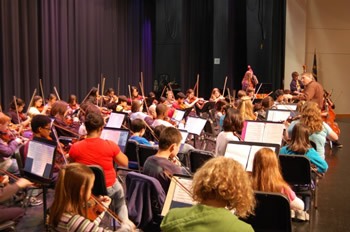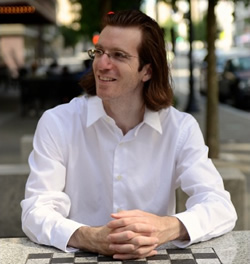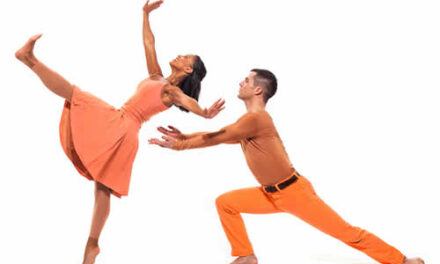 Company SBB narrowly missed me in 2018 when they decided to tour the Spoleto Festival in Italy instead of Spoleto Festival USA. If the company, founded by Stefanie Batten Bland, had turned south instead of east from their New York HQ, my first encounter with them would have given me a more typical sampling of the Jerome Robbins Award winner’s work as a dancer and choreographer. On their recent appearance with Duke Performances, rebranded for the pandemic as their “Show Must Go Online” series, Company SBB veered away from stage presentation in both of their new pieces. “Mondays at Two” gathered its dancers onto the ZOOM platform, building upon the troupe’s weekly meetings, with additional footage shot by individual dancers in imaginative – often surreal – TikTok fashion. “Currents” liberated us from the confines of the SBB dancers’ webcams and cellphone cameras, taking us outdoors to a secluded stream in upstate New York, where a trio of dancers, including Batten Bland, were part of a cinematic design that was ominously surreal and naturally serene.
Company SBB narrowly missed me in 2018 when they decided to tour the Spoleto Festival in Italy instead of Spoleto Festival USA. If the company, founded by Stefanie Batten Bland, had turned south instead of east from their New York HQ, my first encounter with them would have given me a more typical sampling of the Jerome Robbins Award winner’s work as a dancer and choreographer. On their recent appearance with Duke Performances, rebranded for the pandemic as their “Show Must Go Online” series, Company SBB veered away from stage presentation in both of their new pieces. “Mondays at Two” gathered its dancers onto the ZOOM platform, building upon the troupe’s weekly meetings, with additional footage shot by individual dancers in imaginative – often surreal – TikTok fashion. “Currents” liberated us from the confines of the SBB dancers’ webcams and cellphone cameras, taking us outdoors to a secluded stream in upstate New York, where a trio of dancers, including Batten Bland, were part of a cinematic design that was ominously surreal and naturally serene.
Batten Bland’s relaxed webcast introductions not only yielded useful insights on the works that followed but also offered us hints and glimpses of how she inspires her dancers. “Mondays at Two” began with the sort of ZOOM tableau we’ve become accustomed to during our prolonged lockdowns only, instead of crosstalk between 18 participants, there was music by Paul Damian Hogan. Warmups no longer happened haphazardly on a studio floor or on ballet barres against walls and mirrors. In a ZOOM universe, dancers mostly limbered up close to their webcams, stretching their necks or rapidly bobbing their heads so that multiple waves of hair dotted the screen. The claustrophobic confinement of ZOOM meetings was quickly established, humorously followed by stillness, dejection, and undisguised boredom. We could all commiserate.
If dance under normal circumstances explores the possibilities and meanings of motion, it was clear that, in creating her pieces during quarantined pandemic conditions, Batten Bland also wished to convey the sheer preciousness of movement. While all her other dancers slouched, moped, or blankly stared at their monitors, one of the screens in the second row lit up yellow along its frame, inevitably grabbing our attention. The dancer who owned that screen, Claire Gieringer, clearly relished the attention, for the busy eye-catching scene that filled her screen was revealed to be a cellphone as she drew it away from her webcam. At that point, there was a doubled “through the looking glass” reveal sucking us in: we were rushed into the dancer’s bedroom while we zoomed into the dancer’s screen until it was the only screen, all the ZOOM frames stripped away.
Now there was a succession of privately filmed and edited videos from the dancers, individually or in pairs. In-production and post-production, editing created assorted surreal effects, and occasionally multiple videos from multiple sources were juxtaposed. Prevailing themes among the dancers’ videos were walls, halls, and doors. One dancer trembled before a formidable double- or triple-locked front door, another writhed and danced against her door, while yet another dancer emerged from a closet into her partner’s bedroom. One of the cellphones was propped inside a drawer or storage nook, yielding a similar feel as a dancer peered in. Perspectives were often strange and unique as the experiences of cabin fever and confinement were explored. Only in the final sequence, filmed by a middle-aged couple, did anybody venture outside – and even then, the excursion was brief and plagued with distrust. The turning back of the male partner to the anxious female partner waiting at the front door circled us back to the full troupe on their ZOOM screens. They could have been kissing us or each other goodbye as we faded out, but the meaning of their parting moues was ambiguous.
While “Current” took us outdoors, neither the weather nor the mood was sunny. Jean Claude Dien’s cinematography left the opening sequence a bit cryptic, for he was expecting us to notice the falling of a single yellow leaf – the preciousness of motion – against a relatively vast forest scene. Unlike Gieringer’s antics, the falling leaf could be overlooked, though the principle was the same: a small spot of activity amid a vast surrounding stillness. We cut to a leaf, presumably that leaf, as it floated downstream until it collided with the arm of Jennifer Payán, lying motionless in the shallow water. Soon we had a shot of a canoe adrift on the stream and then a gloomier cliffside scene along the shore, where the three dancers performed individually or collectively, never really connecting or acknowledging each other’s presence. In the dim light near the cliff, movements seemed particularly anguished, desperate, and despairing. The dancers’ wide-eyed blankness put me in mind of how the insane Renfield is usually portrayed onstage in productions of Dracula. Joining Payán in these eerie revels was Batten Bland and Oluwadamilare Ayorinde. Neither of the women’s full, silky dresses, designed by Shane Ballard, was especially intended for camping or canoeing, and Ayorinde’s outfit, pants and vest cut from a khaki-colored tweed, was more suited for a night on an urban street than an afternoon on a lonely stream.
As the camera repositioned and we saw the dancers positioned in front of the stream, movement became more dazed. Batten Bland was the most inert, seemingly catatonic. When his tempo quickened, Hogan’s music came to the forefront of the cinematic concept as the dancers began shaking and trembling. Intercut with this suddenly spasmodic choreography, we saw shots of the rushing water, and the sound of the water suddenly became prominent in the soundscape, hushed as suddenly as it was unleashed. More spasmodic action and quicker cuts ensued as the drumbeat reached the apex of its crescendo. All three dancers were shown individually in the water – luxuriating, lazing, or warily hunting – or collectively huddled onshore, still emotionally disconnected from one another, perhaps too enervated to connect. As if all we had seen since the opening sequence had been a flashback, the music and the action subsided. The pace of the water’s flow was greater now than before, and we saw more leaves going with the flow. At last, the leaves led us back to the dancers, all recumbent in the shallow water, as lifeless as before. Rather than morbidly fatalistic, the lingering impression was of a lyrical beauty, of a place where nature’s eternal cycles prevail.













